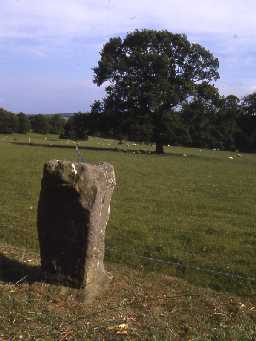Local History
Newbrough and Fourstones (Northumberland)
Newbrough parish lies in south Northumberland, in the Tyne valley. There is a range of archaeological and historic sites from prehistoric to post-medieval times. The many Roman remains in the parish are associated with Hadrian's Wall and its predecessor, the Stanegate.
The earliest remains in the parish are Bronze Age and all are associated with burials. Two round cairns near Middle House may cover cist burials but a cist burial was discovered by a farmer at Allerwash in 1972. Inside, were human remains and a bronze dagger.
The oldest settlements in the parish are Iron Age. One survives only as cropmark at Newbrough, but others remain as earthworks, such as Meggie's Dene Burn West and South Carrawburgh. Aerial photography has also shown up the faint traces of prehistoric ploughing, called cord rig at Little Crag and Brown Moor. Some of these farmsteads may have been occupied in Roman times, such as Grindon Hill, but a new one seems to have been established at Shield on the Wall.
Although Hadrian's Wall is perhaps the best known Roman monument in the parish, the Stanegate Roman road is an earlier feature. This may have been the first Roman frontier in the north and was probably built between Carlisle, (Cumbria), and Corbridge Red House fort in the first century AD. Remains of the road have been recorded by archaeologists at Newbrough as well as contemporary forts at Newbrough and Sidgate. Hadrian's Wall was built across the area in the second century AD with turrets, milecastles and a fort at Carrawburgh. Many of these remains survive as upstanding earthworks. The fort at Carrawburgh has been partially excavated and features there include a civilian settlement, or vicus, a bath house, Coventina's Well, a mithraeum and a cemetery. Behind Hadrian's Wall are two temporary camps at Brown Moor and Brown Dikes, though their dates are unknown. The Romans may have pioneered lead mining at Settlingstones.
In medieval times, there seems to have been quite a large population in the area with people living in villages and hamlets at Howden, Hawden, Wharmley, Thornton, Newbrough, Stonecroft, Side, Allerwash and Carraw. A chapel stood at the west of the village on a site now occupied by the Church of St Peter. However, these were not the most settled of times, with wars between England and Scotland threatening the area. Some built defensive buildings, called tower houses, at Settlingstones and Thornton.
The post-medieval period was a more peaceful time and developments were made in farming and industry. New farm buildings were built at Allerwash and some fine buildings in Newbrough village as well as some rather grander country houses, such as Newbrough Hall, Newbrough Lodge and Newbrough Park and its grounds. Newbrough Hall was also an early advocate of electricity and had its own power house in 1902. A few years later, in 1908, the world's first scout camp is said to have been held at Carr Edge Farm by Lord Baden-Powell.
The earliest remains in the parish are Bronze Age and all are associated with burials. Two round cairns near Middle House may cover cist burials but a cist burial was discovered by a farmer at Allerwash in 1972. Inside, were human remains and a bronze dagger.
The oldest settlements in the parish are Iron Age. One survives only as cropmark at Newbrough, but others remain as earthworks, such as Meggie's Dene Burn West and South Carrawburgh. Aerial photography has also shown up the faint traces of prehistoric ploughing, called cord rig at Little Crag and Brown Moor. Some of these farmsteads may have been occupied in Roman times, such as Grindon Hill, but a new one seems to have been established at Shield on the Wall.
Although Hadrian's Wall is perhaps the best known Roman monument in the parish, the Stanegate Roman road is an earlier feature. This may have been the first Roman frontier in the north and was probably built between Carlisle, (Cumbria), and Corbridge Red House fort in the first century AD. Remains of the road have been recorded by archaeologists at Newbrough as well as contemporary forts at Newbrough and Sidgate. Hadrian's Wall was built across the area in the second century AD with turrets, milecastles and a fort at Carrawburgh. Many of these remains survive as upstanding earthworks. The fort at Carrawburgh has been partially excavated and features there include a civilian settlement, or vicus, a bath house, Coventina's Well, a mithraeum and a cemetery. Behind Hadrian's Wall are two temporary camps at Brown Moor and Brown Dikes, though their dates are unknown. The Romans may have pioneered lead mining at Settlingstones.
In medieval times, there seems to have been quite a large population in the area with people living in villages and hamlets at Howden, Hawden, Wharmley, Thornton, Newbrough, Stonecroft, Side, Allerwash and Carraw. A chapel stood at the west of the village on a site now occupied by the Church of St Peter. However, these were not the most settled of times, with wars between England and Scotland threatening the area. Some built defensive buildings, called tower houses, at Settlingstones and Thornton.
The post-medieval period was a more peaceful time and developments were made in farming and industry. New farm buildings were built at Allerwash and some fine buildings in Newbrough village as well as some rather grander country houses, such as Newbrough Hall, Newbrough Lodge and Newbrough Park and its grounds. Newbrough Hall was also an early advocate of electricity and had its own power house in 1902. A few years later, in 1908, the world's first scout camp is said to have been held at Carr Edge Farm by Lord Baden-Powell.
N13860
UNCERTAIN
Disclaimer -
Please note that this information has been compiled from a number of different sources. Durham County Council and Northumberland County Council can accept no responsibility for any inaccuracy contained therein. If you wish to use/copy any of the images, please ensure that you read the Copyright information provided.
